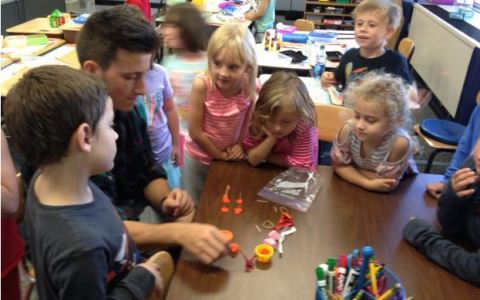Town of Webb Union Free School District - Over Five Years of Innovation in the Classroom
By John Swick, K-12 Principal, Town of Webb Union Free School District, jswick@towschool.org
The Town of Webb UFSD began its 1:1 computer initiative five years ago. Today, the K-2 classrooms use shared tablets; third graders share tablets as well as Chromebooks; and each child in grades 4-12 has a Chromebook. Students in grades 4-5 keep the computers on a cart in their classrooms and learn about Chromebook care, while students in grades 6-12 are allowed to take their device home with them each night. In order to allow students to use their preferred devices, the district has encouraged students to "Bring Your Own Devices" (BYOD) throughout the implementation of its 1:1 computer initiative.
Google Classroom has been utilized districtwide to facilitate classroom activity every day. This is in addition to Schooltool for our secure Student Management System for report cards and grades. In addition, some teachers have even began using the G Suite functions to give midterm exams and finals for quicker grading and feedback in our junior and senior high schools. Kindergarten classes use Class DoJo as their behavior management system to communicate with parents. Due to our school’s commitment to social media information sharing, we were able to eliminate our paper newsletter altogether. Many teachers and coaches use Remind 101 to communicate with students and parents on a daily basis. We now use the school website, Twitter, and Facebook to communicate with families in addition to the School Messenger Emergency Alert System. Utilizing the built-in webcams in our Chromebooks, we have enabled mental health professionals to communicate with student patients online from the privacy of their homes. This has worked well for students looking to avoid the stigma of visiting a mental health professional or for those who do not have the means to travel to an office.
Our AP Biology class has been engaging in Project Based Learning (PBL), active learning, and device implementation. Many labs have been modified for students to design their own experiments to test new phenomena, and then use these results to learn more about these phenomena (diffusion, for example). Devices are used to share data both during and after labs so that students can use statistical analysis on data to better understand and analyze data from their labs.
Device implementation and PBL is happening in our new Bioethics elective course while students are researching topics of interest on their own devices. They are using information both given to them, and what they find on their own to form their opinions on ethical questions. They use their Chromebooks to both research, and write papers on their positions.
Mr. Cunningham created what he calls YOU UNIVERSITY with his English classes (10-12) for the purposes of establishing their career goals and personal goals. Each student uses their developed YOU GOALS to research on the internet information on their career path including colleges, curriculum, current issues within their areas, and famous people in their career area. They do the same with their personal goals which might include everything from weight loss, to speaking in public, or learning how to throw a curveball. They are encouraged to outline information as well as quoting important information in their writing.
Every day in first grade classes for a math warm-up, we complete a STEM bin project (Science, Technology, Engineering, Math). The bins are kept in our desks for easy/quick access. We have a project we must produce in five minutes, e.g.. house, bridge, robot. We can only use the supplies provided in our bin, e.g. blocks, index cards with tape, pipe cleaners, LEGO bricks. After five minutes, we walk around the classroom and give positive feedback to one another on our completed projects. They love the challenge each day and can't wait to hear the next day's project.
In English classes, grades 7- 9, we use a number of digital learning sites to help differentiate instruction. The teacher is already utilizing readtheory.org and newsela.com to help me determine the current reading levels of my students. After studying the data from both sources, the teacher comes up with successful small reading groups to start the new year off with.
As a school, we have begun a small agricultural program with Mr. Best in fifth grade. This consists of eight raised gardens that were designed within a teacher-student collaboration as well as one traditional no-till bed. This is open to all grades and to the senior citizen program as well as the summer recreation program with the help of the Cornell Cooperative Extension. We have also started a small maple program where students are taking daily data to compare sap collection levels with temperature fluctuation to identify the most productive times to collect sap. We added temperature sensors with probes for air and soil temperatures in the raised beds and we plan to add temperature sensors at varying altitudes to get the most precise temperature data for sap collection and soil air temperatures for growing. Students in fifth grade are collaborating with North Carolina State University in a long-term study of the effects of urbanization on the growth and health of red maples. The fifth grade is also working on projects focused on coding, robotics, engineering, entrepreneurship, and philanthropy.
Students in Kindergarten have started a worm farm to identify the effects of decomposers to the environment. First grade students tested the effects of potato growth when grown in buckets while second grade students grew pea shoots and identified them as a renewable food source with low cost to begin growing/grow. Third grade students worked on developing a weather observation station, while fourth grade students are growing a three sisters garden.
In the works, first and third grades will be hatching monarch butterflies and tag them to be entered into an international database (NYS DEC). All elementary and middle school will be raising trout in the classroom at two stations (one in the elementary and one in the middle school). We hope to extend the maple program from just tapping into manufacturing. First and second grades will incubate chicken eggs as well.
The Town of Webb UFSD Library is doing some very exciting things with Makerspaces. There are many different stations set up around the library for all grade levels that encourage critical thinking, problem solving, teamwork, construction, and engineering skills. All of the makerspaces encourage hands on, active learning and are diverse enough that any student can find something that holds their interest.
Our district purchased and is utilizing “Keyboarding Without Tears” this year to help students become proficient keyboarders. Our special needs students are getting their needs met utilizing the same technology utilizing various programs including: Read & Write for Google, Snap Type for the iPad, Bookshare, Clicker Sentences for the iPad, and many more.
This year, we started our first coding class through Edhesive called “Introduction to Computer Science.” Our foreign language teacher teaches this class. For many students, this is a foreign language and another area to excel in the classroom. We are continuing to run our photography/video class this year for students to capture the artistic talents of our students. Our elective for Seniors to enhance their career skills is called ESCO which places seniors up to three periods with a professional in the school or community in an area that the student is considering for employment. This includes teachers, business owners, the snowmobile shop, our diesel mechanic, surveying, and many more.
Last year we started a Robotics club in fourth grade. Students began working after school with Dash and Dot LEGO kits and now our PTC is fundraising to purchase more kits for this club. Our fourth grade teacher has attended professional development for this through our BOCES. The teacher had no previous experience with programming or coding and has excelled in gaining student interest in this topic. Our fourth grade students also took first place in New York State’s Sumdog Spring Competition last year. This is a competition where students complete as many math problems as they can in a week-long period online and are given a score for accuracy and completion rates. Our fifth grade students have been battling our fourth grade students all year for the top spot in the competitions online.
As a school we are committed to cloud printing. Classroom printers were phased out and now printers are located in a few convenient locations around the building. The photocopy machines in our offices are also now capable of scanning and emailing documents to conserve paper. Our physics teacher recently wrote a grant to our local Community Scholarship Foundation and received a 3D printer providing the opportunity to use in several classrooms and grade levels. Students have created and designed these items themselves.
Through the Smart Schools Bond Act funding our schools network infrastructure is undergoing an upgrade on both the wired and wireless systems. The school is installing all new network switches, wireless controllers, connectivity management application, wireless access points, uninterrupted power supplies, and creating redundancy at all levels of the infrastructure. We’ve recently installed 10GB fiber optic cable throughout the school to create 10GB connectivity between our network closets and to our client connections. A new VoIP and PA system upgrade project is running parallel to our network infrastructure upgrade project, which will be replacing our aging VoIP phone system and analog PA system. We will be using a SIP application to control all of our bell scheduling and announcements, with using VoIP phones in the classrooms and IP speakers in the hallways, larger common areas, and outside our building for the audio outputs.
While planning for our network infrastructure upgrade, a new fiber optic project came to the school's attention when a fiber optic company was exploring locations around our town for their fiber optic central office to be built. This new fiber optic project was both federally and state approved and funded, which will complete a fiber circuit from Tupper Lake, NY to Marcy, NY, with the fiber optic cable passing through Old Forge, NY. After a meeting with the town, our school, and the fiber optic company, it was determined that the school was the best location for this central office. Through this project, the school partnered with the fiber optic company Development Authority of the North Country (DANC) and has become their network hub location. Through this new partnership, the school was able to have strands of fiber installed coming from the school into each of the six town inter-municipalities buildings. This new fiber optic circuit is creating new technology opportunities for the town and school to explore. We are now creating a partnership to provide internet to these six buildings using the school’s ISP for connectivity, along with putting plans in place for the school to provide VoIP phone system and managed wireless connectivity in the future. The school and town see this as another opportunity to expand our shared services as a cost savings approach to our stakeholders.
We've recently deployed four temperature sensors that are connected to the internet (this is known as the Internet of Things devices, IOT) around the school to collect temperature readings to help us monitor temperatures in real time and to create real data for teachers and students to use in the classrooms. The sensors are currently located in the following places: kitchen food cooler, kitchen ice cream cooler, data center room, and in a raised bed garden which is collecting air and soil temperature using a probe. Students and teachers can view this live data on our website to use in the classroom. This was made possible through our school partnership with PAR Technology in New Hartford, NY.







